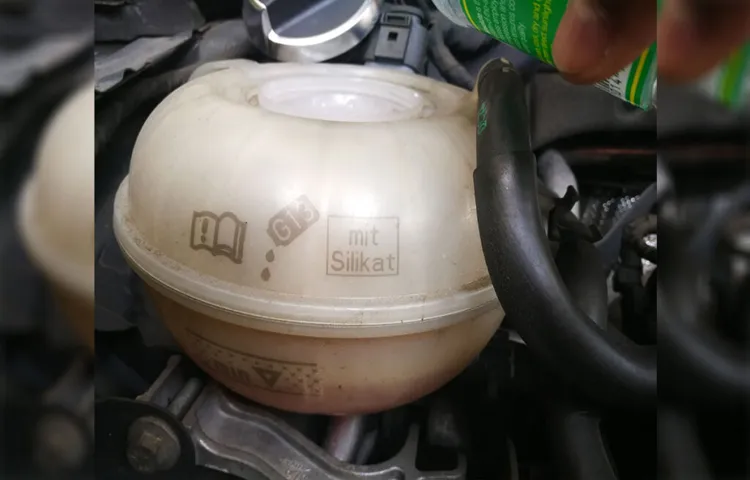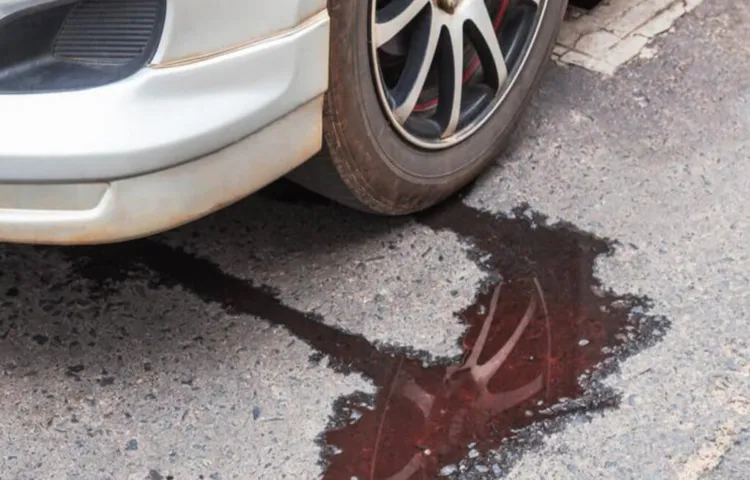Hey there car enthusiasts! Have you noticed a strange smell coming from your engine? Or maybe you’ve noticed a puddle of liquid underneath your vehicle? Well, it could be a sign that your coolant is leaking into the engine. But, how can you be sure? Don’t worry, we’ve got you covered. In this blog post, we’ll discuss some telltale signs that your coolant is making its way into places it shouldn’t be and what you can do about it.
So, buckle up and let’s dive into how to identify coolant leaking into the engine!
Table of Contents
Introduction
Are you concerned about whether coolant is leaking into your engine? If so, there are several signs to look out for that can indicate a coolant leak. One of the first signs is if you notice a sweet smell coming from your engine or see a puddle of brightly colored fluid under your car. Another indication is if your engine temperature gauge is consistently reading high or if you notice that your car is overheating.
Additionally, you may see white smoke or steam coming from your exhaust pipe, which can be a sign of coolant leaking into the combustion chamber. It’s essential to address this issue as soon as possible to prevent any further damage to your engine. If you suspect a coolant leak, it’s best to have your car inspected by a professional mechanic who can accurately diagnose and fix the problem.
Importance of identifying coolant leaks in the engine
The importance of identifying coolant leaks in the engine cannot be overstated. Coolant plays a crucial role in regulating the temperature of the engine, preventing it from overheating and causing damage. When there is a leak in the coolant system, the engine is at risk of running hot, which can lead to a range of problems and potentially expensive repairs.
Identifying and addressing coolant leaks early on can save you both time and money, as well as prevent further damage to your engine. So, how can you tell if your engine has a coolant leak? Let’s dive into the signs and symptoms to watch out for.

Common signs of coolant leaking into the engine
coolant leaking into the engine Introduction: Have you ever noticed a puddle of liquid under your car? It could be a sign of coolant leaking into the engine. Coolant, also known as antifreeze, is a vital component of your car’s cooling system. It helps regulate the temperature of your engine, preventing it from overheating.
When coolant leaks into the engine, it can cause several problems and potentially lead to costly repairs. In this blog post, we will discuss the common signs of coolant leaking into the engine and why it is important to address this issue promptly. So, let’s dive in and find out how to identify this problem before it causes significant damage to your vehicle.
Step-by-Step Guide
Have you noticed a strange sweet smell coming from under your car’s hood? Or maybe you’ve seen a greenish-yellow fluid pooling underneath your vehicle? These could be signs that coolant is leaking into your engine, and it’s something you’ll want to address as soon as possible. Coolant, also known as antifreeze, is a crucial component in your engine’s cooling system, and if it’s leaking into the engine, it can cause serious damage. So how can you tell if coolant is indeed leaking into your engine? One common indication is a white, sweet-smelling smoke coming from the exhaust pipe.
This is a sign that coolant is being burned along with the fuel, and it’s a clear red flag that something is wrong. Another clue is an overheating engine. If your engine is constantly running hot, despite having a sufficient amount of coolant, then it’s likely that coolant is leaking into the engine and not circulating properly.
Additionally, if you notice a milky substance in your oil or coolant reservoir, it could be an indication of a coolant leak. This is because the coolant mixes with the oil or other fluids in the engine, creating a frothy, milky appearance. If you suspect a coolant leak, it’s important to have your vehicle inspected by a professional mechanic.
They can diagnose the issue and recommend the necessary repairs to prevent further damage to your engine. Remember, addressing a coolant leak early can save you from costly repairs down the road.
Step 1: Locate the coolant reservoir
coolant reservoir
Step 2: Inspect the coolant level
Now that you’ve checked the radiator cap and made sure it’s cool, it’s time to move on to the second step in inspecting your coolant: checking the coolant level. This is an important step because the coolant is what keeps your engine from overheating. If the coolant level is too low, it can’t do its job effectively and can lead to engine damage.
To check the coolant level, locate the coolant reservoir. This is usually a clear plastic tank located near the radiator. The reservoir will have “min” and “max” level markers on the side.
Make sure the engine is cool before removing the reservoir cap. Once the cap is off, take a look inside. The coolant level should be between the “min” and “max” markers.
If it’s below the “min” marker, you’ll need to add more coolant. When adding coolant, be sure to use the correct type for your vehicle. Refer to your owner’s manual or consult a professional if you’re unsure.
Slowly pour the coolant into the reservoir, being careful not to overflow it. After adding coolant, replace the reservoir cap securely. It’s important to make sure the cap is tight to prevent coolant from leaking out.
Checking the coolant level is an essential step in maintaining your vehicle’s cooling system. By keeping an eye on the coolant level, you can ensure that your engine stays properly cooled and avoid potential issues down the road. So take a few minutes to inspect your coolant level, and keep your engine running smoothly.
Step 3: Check for white smoke from the exhaust
In this step of our guide on how to diagnose car problems, we will discuss how to check for white smoke coming from the exhaust. White smoke can be a sign of several issues with your car’s engine, and it’s important to identify the cause in order to address the problem effectively. So, how do you go about checking for white smoke? First, start your car and let it run for a few minutes to warm up.
Then, take a look at the exhaust pipe. If you see white smoke coming out, it could indicate a coolant leak. This could be the result of a blown head gasket or a cracked engine block.
In this case, it’s important to have your car inspected by a qualified mechanic as soon as possible, as continued driving with a coolant leak can lead to engine damage. However, it’s worth noting that white smoke can also be caused by condensation in the exhaust system, especially on cold mornings. To determine the cause of the white smoke, pay attention to the smell.
If it smells sweet, like antifreeze, it’s likely a coolant leak. On the other hand, if the smoke smells burnt, it could be a sign of oil leaking into the combustion chamber. Again, in this case, it’s important to have your car checked by a professional to prevent further damage.
Remember, diagnosing car problems can be tricky, but by following these steps, you can get a better idea of what’s going on under the hood.
Step 4: Look for milky oil
In this step-by-step guide, we’re going to talk about how to look for milky oil in your car. Milky oil is a telltale sign of a serious problem that needs to be addressed immediately. So, how do you check for milky oil? First, start by opening your car’s hood and locating the oil dipstick.
Pull it out and examine the color and consistency of the oil on the dipstick. If the oil is a light tan or milky white color, that’s a sign that there is water or coolant mixing with the oil. This could indicate a leak in the head gasket or a cracked engine block, which are both serious issues that need to be fixed by a professional mechanic.
So, if you notice this milky appearance in your oil, don’t ignore it. Take your car to a mechanic right away to prevent further damage to your engine.
Step 5: Examine the spark plugs
The next step in our guide to examining your car’s spark plugs is to actually take a close look at them. Spark plugs play a vital role in the ignition process of your engine, so it’s important to make sure they are in good condition. Start by removing one spark plug at a time using a spark plug socket and ratchet.
Take note of any buildup or deposits on the spark plug. If you notice excessive deposits, it could indicate an issue with your engine, such as a rich fuel mixture or oil consumption. Additionally, check the electrode gap to ensure it is within the manufacturer’s specified range.
If the gap is too large or too small, it can result in poor combustion and misfires. Finally, take a look at the spark plug’s porcelain insulator. If you see any cracks or signs of damage, it’s time to replace the spark plug.
By examining your spark plugs regularly, you can catch potential issues early and keep your engine running smoothly.
Step 6: Perform a compression test
compression test, engine diagnosis, car maintenance, engine performance, internal combustion engine Performing a compression test is a crucial step in diagnosing engine problems and ensuring proper maintenance of your car. This test helps determine the health and performance of your engine’s internal combustion process. By measuring the compression levels in each cylinder, you can identify potential issues such as worn piston rings, valves, or cylinder head gaskets.
To start the compression test, you will need a compression tester, which can be purchased or rented from an auto parts store. Begin by removing all the spark plugs and disconnecting the ignition coil or fuel injector to prevent the engine from starting. Install the compression tester in place of the spark plug in one cylinder and crank the engine over a few times to build up pressure.
Read the compression gauge and record the reading for that cylinder. Repeat this process for each cylinder in your engine. The compression readings should be relatively consistent across all cylinders.
If you notice a significant difference in compression levels between cylinders, it may indicate potential problems. Generally, a healthy engine should have compression readings between 120 and 170 psi (pounds per square inch). However, specific values may vary depending on your vehicle’s make and model, so it’s essential to consult your car’s manual or a reputable mechanic for the correct specifications.
When analyzing the compression test results, keep in mind that low compression could be a sign of piston ring or valve-related issues. High compression, on the other hand, may indicate carbon buildup, a problem with the cylinder head gasket, or a carbonized valve. These issues can affect engine performance, fuel efficiency, and overall reliability.
By performing a compression test regularly and comparing the results over time, you can monitor the health of your engine and detect potential problems early on. This proactive approach to car maintenance can save you from costly repairs down the line and ensure that your vehicle continues to run smoothly. So, the next time you’re performing engine diagnostics or routine maintenance, don’t forget to include a compression test in your checklist!
Prevention and Maintenance Tips
Detecting a coolant leak in your engine is essential for maintaining the health and performance of your vehicle. One way to determine if coolant is leaking into your engine is by inspecting the coolant reservoir. If you notice a significant decrease in the coolant level without any apparent reason, it may be a sign of a leak.
Additionally, check for any puddles or stains under your car, which could indicate a coolant leak. Another way to tell if coolant is leaking into your engine is by monitoring the temperature gauge. If your engine is running hotter than normal, it could be a sign that coolant is escaping.
It is important to address a coolant leak promptly to prevent further damage to your engine. Regularly checking for leaks and maintaining your cooling system can help prolong the life of your engine and ensure optimal performance.
Regularly check the coolant level
coolant level, prevention and maintenance tips
Inspect hoses and connections
hoses and connections When it comes to maintaining your car and keeping it running smoothly, one important aspect to pay attention to is the hoses and connections. These parts play a crucial role in the functioning of your vehicle, so it’s essential to regularly inspect and maintain them. Hoses are responsible for carrying various fluids in your car, such as coolant, power steering fluid, and brake fluid.
Over time, these hoses can become worn out and develop cracks or leaks. If left unattended, this can lead to fluid loss, which can cause serious damage to your car’s engine or braking system. Connections, on the other hand, refer to the joints where different hoses or components of your car come together.
These connections are also prone to wear and tear, and if they become loose or damaged, it can lead to fluid leaks or even complete failure of the affected system. To prevent any potential issues, it’s a good idea to visually inspect your hoses and connections regularly. Look out for any signs of wear, such as cracks, bulges, or leaks.
Additionally, check for any loose connections or signs of corrosion. If you notice any issues, it’s important to address them promptly. Replace any worn-out hoses or damaged connections to avoid potential problems down the line.
Regularly checking and maintaining these parts can save you from costly repairs and ensure that your car remains in good working condition. In conclusion, inspecting your hoses and connections is an important part of car maintenance. By keeping an eye on these parts and addressing any issues promptly, you can prevent potential problems and ensure that your vehicle continues to run smoothly.
So, take a few minutes to inspect your hoses and connections regularly, and give your car the care it deserves.
Monitor the temperature gauge
“temperature gauge” Maintaining your vehicle’s temperature gauge is an important part of preventing any potential issues with your engine. The temperature gauge provides crucial information about the temperature of the engine coolant, helping you monitor if it’s staying within a safe operating range. This is particularly important during long drives, hot weather, or when towing heavy loads.
By regularly checking the temperature gauge, you can catch any abnormalities early on and take necessary action to prevent overheating or other engine problems. Remember, prevention is always better than cure when it comes to maintaining your vehicle’s performance and avoiding costly repairs. So, make it a habit to keep an eye on that temperature gauge and ensure your engine stays cool under pressure.
Perform routine coolant flushes
coolant flushes, prevention and maintenance tips
Conclusion
In conclusion, detecting a coolant leak in your engine is like playing detective with a twist. But don’t fret, with a keen eye (maybe even a magnifying glass!) and a nose for sniffing out clues, you can easily crack the case. Remember, if your coolant mysteriously disappears, leaving no trace behind, it’s a sign that something fishy might be going on.
Keep an eye out for those sneaky puddles of brightly colored liquid under your vehicle, as they could be the smoking gun pointing to a coolant leak. But fear not! If you’re unsure whether you’re dealing with a coolant leak or just a mild case of car sweating, take a whiff. If the aroma is sweet like a summer breeze on a tropical island, chances are your engine is secretly sipping on the coolant potion.
And lastly, listen closely. If your engine starts singing a tune that’s off-key – like a symphony of bubbling, gurgling, or hissing – it’s time to raise your detective antenna and investigate further. So, fellow sleuths of the automotive world, armed with your knowledge and a trusty dipstick, you can now unmask the elusive coolant leak hiding within your engine.
Together, let’s keep our engines cool and running smoothly, solving mysteries one leak at a time.”
Importance of addressing coolant leaks promptly
coolant leaks, preventive maintenance
Seek professional help if needed
“professional help” Seeking professional help is essential when it comes to maintaining and preventing issues in your daily life. Whether it’s seeking advice from a therapist, consulting with a financial planner, or asking for guidance from a career coach, professionals can provide valuable insights and tools to help you navigate challenging situations. These experts have the knowledge and experience to offer tailored advice and strategies that can help you overcome obstacles and achieve your goals.
While self-help resources and online forums can be useful, they may not always address your specific needs or circumstances. By seeking professional help, you can benefit from personalized guidance and support that can make a significant difference in your well-being and success. Don’t hesitate to reach out for assistance whenever you feel overwhelmed or stuck.
Remember, asking for help is a sign of strength, not weakness, and can lead to breakthroughs and personal growth.
FAQs
How do I detect if coolant is leaking into my engine?
There are a few signs that can indicate a coolant leak in your engine. Look out for white smoke coming from the exhaust, a sweet smell inside the cabin, or an unusually high engine temperature. You can also check the coolant level regularly and inspect for any visible leaks under the hood.
What are the possible causes of coolant leaks into the engine?
Coolant leaks into the engine can be caused by a variety of issues. Some common causes include a faulty head gasket, a cracked engine block or cylinder head, a leaky radiator, or a damaged water pump. It is best to have a professional mechanic diagnose the exact cause of the leak.
What are the risks of coolant leaking into the engine?
Coolant leaking into the engine can lead to serious engine damage if not addressed promptly. It can cause overheating, cylinder misfires, and even hydrolock, where coolant fills the combustion chambers and prevents the engine from turning over. It is important to address any coolant leaks as soon as they are detected.
Can a coolant leak into the engine be fixed without replacing major components?
In some cases, a coolant leak into the engine can be fixed without replacing major components. If the leak is minor and caused by a small gasket or seal failure, it may be possible to repair it by replacing the faulty part. However, if the leak is due to a more serious issue like a cracked engine block or head, major component replacement may be necessary.
How much does it cost to repair a coolant leak into the engine?
The cost of repairing a coolant leak into the engine can vary depending on the cause and severity of the leak. Minor repairs like replacing gaskets or seals can cost a few hundred dollars, while major repairs like replacing an engine block or cylinder head can cost several thousand dollars. It is best to get a professional diagnosis and quote for an accurate cost estimate.
Can I drive my car with a coolant leak into the engine?
It is not recommended to drive your car with a coolant leak into the engine. Coolant is essential for regulating the engine temperature and preventing overheating. Driving with a coolant leak can lead to engine damage, loss of engine power, and even complete engine failure. It is best to have the issue addressed before driving the vehicle.
How can I prevent coolant leaks into the engine?
Regular maintenance and proper care can help prevent coolant leaks into the engine. Follow manufacturer’s recommendations for coolant flushes and replacements. Keep an eye on the coolant level and inspect for any visible leaks. Address any warning signs of a coolant leak promptly to avoid further damage.



